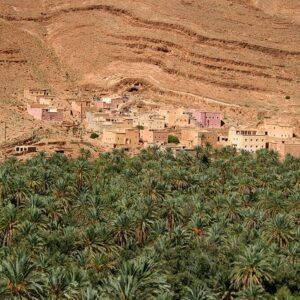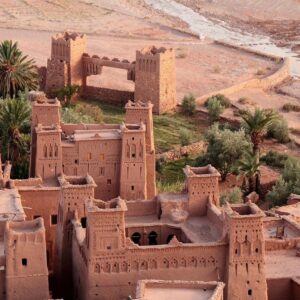Description
Day 1 Arrival in Marrakesh
We fly to Morocco, where we will be picked up at the airport and driven to the hotel.
Meals: Dinner if we arrive in the afternoon. If we arrive later, dinner is not included on this day.
Accommodation: Marrakesh
Day 2 Exotic Marrakesh
We have the whole day to explore Marrakesh, a magical city. The city was the main city of the Almoravids in the 11th century, and it lies like an oasis on the edge of the desert and at the foot of the Atlas Mountains. All roads lead to Djemaa el Fna Square, where musicians, dancers, acrobats, healers, writers, storytellers, snake charmers, and fruit vendors gather. It’s a colorful sight and an experience that sticks in the memory. When lanterns are lit, the square comes to life, filled with the scent of grilled meat, couscous, and delicious cakes. And the souk, a labyrinth of light and shadow under the protective canopy of woven straw, turns every evening into a festival of colors, sounds, and scents.
You turn a corner, and suddenly you find yourself at a half-open door, through which you can catch a glimpse of a palace with a fountain in the foreground. Perhaps the Bahia Palace with gardens filled with jasmine and orange blossoms. Or the mighty minaret of the Koutoubia Mosque, towering over the city’s rooftops. We visit both the Bahia Palace and the Koutoubia Minaret on our tour through the old Medina. Along the way, we have lunch at a local restaurant.
Meals: Breakfast and lunch
Accommodation: Marrakesh
Day 3 Marrakesh – Ait Ben Haddou
The day offers a beautiful drive to the medieval city of Ait Ben Haddou. Small Berber villages cling to the mountainsides, and in the valleys, pomegranate trees, walnut trees, and poplars grow. Sheep and goats graze on the mountainsides.
Here in the Atlas Mountains, the dramatic landscape has undergone countless changes in the 2 million years the granite mountains have existed. Once, Morocco was completely covered by water, leaving behind a rich variety of fossils from the various marine animals that lived here. Several small stalls along the roadside sell these fossils. The journey takes us over the Tizi n’Tichka pass at an altitude of 2205 meters before we continue along beautiful roads down towards the desert.
The kasbah town of Ait Ben Haddou emerges in the landscape as a pure revelation. A kasbah is a group of interconnected houses with a wall around them. A building style that originated from the need to defend against foreign tribes. Situated high above the Ounila Valley, the city is one of the oldest and most picturesque desert cities in the country, built of sun-dried mud, straw, and earth.
The oldest of the buildings, a granary located on a hilltop, dates back to the 11th century. There are many unique buildings with towers and geometric patterns. Ait Ben Haddou has been used as a backdrop in blockbuster films such as “Lawrence of Arabia,” “Gladiator,” and more. The city is also on UNESCO’s list of World Heritage Sites.
The tour guide will recount a time when Ait Ben Haddou was a hub on the caravan route between the Sahara and Marrakesh. The caravans brought gold, salt, and slaves.
Meals: Breakfast and dinner
Accommodation: Ait Ben Haddou
Day 4 Ait Ben Haddou – along the kasbah route to the Dades Valley
After breakfast, we drive onto the “road of a thousand kasbahs” and visit the Skoura oasis, where one of the most famous kasbahs, Kasbah Amerdil, is located like a large fortress overlooking the often dried-up river. The building is a magnificent sight from the outside surrounded by the oasis’s palm trees, but we also go inside and see what the beautiful building looks like behind the high walls. The area around Skoura, Kelaat M’Gouna, is known for its rose festival every year in May. Morocco’s largest extraction of rose water and rose oil takes place here.
In the late afternoon, we arrive at the “Gorge du Dades” (Dades Gorge), where we are accommodated in an exciting and beautifully located kasbah. We are now at an altitude of 1709 m, surrounded by the majestic Atlas Mountains. We can enjoy views of both the snow-capped Atlas Mountains and down over the Dades Valley, where the small Berber villages are scattered across the landscape.
Today’s drive is approximately 315 km.
Meals: Breakfast and dinner
Accommodation: Dades Valley
Day 5 Along the Road of a Thousand Kasbahs to the desert town of Merzouga
Early in the morning, we start driving towards Merzouga, our accommodation located right on the edge of the desert. We pass through several small interesting towns such as Tinghir and Erfoud. Tinghir is located in the heart of the Todra Valley between the High Atlas and the Jebel Saghro mountain range. Here is a beautiful and extensive palm grove. Tinghir is an old French garrison town. It was built around a cliff, and today it is dominated by the ruins of an old palace for the famous Glaoui dynasty. We continue driving with time for photo stops and a good lunch break.
We stop in Erfoud, a charming town in the heart of the desert. This small town is located at the foot of the High Atlas on the “road of a thousand kasbahs.” The French were the first to settle in Erfoud with the aim of keeping an eye on the unruly desert tribes in the Tafilalet Valley. The town flourished thanks to trade in marble and dates. It is also known for fossils found in large quantities in this area. They are all around 360 million years old.
In the late afternoon, we arrive at the desert town of Merzouga and our accommodation, facing directly towards the ochre-colored sand dunes of the desert. We have two nights at a small cozy hotel, directly overlooking the reddish-golden sand dunes.
Today’s drive is approximately 250 km.
Meals: Breakfast and dinner
Accommodation: Merzouga
Day 6 A village in the Sahara
The monumental sand dunes of the desert constantly change shape depending on the wind conditions. Colors and shadows shift, making the experience truly unique. The further east you go, the more wild and lonely the landscape seems, and civilization seems far, far away.
Merzouga is a small village in the Sahara in southeastern Morocco in the Tafilalet Valley at the foot of the Erg Chebbi sand dunes. For centuries, this place has been at a crossroads between African desert civilizations. Goods and ideas were exchanged between different cultures. Many kasbahs served as caravanserais for trade caravans.
For the early risers, the sunrise can be enjoyed from the top of a sand dune. It is a very special experience to see the sunrise in the desert.
We have exchanged our bus for 4×4 vehicles, which take us on a half-day tour into the desert. We visit an oasis and also hope to have the opportunity to visit some of the nomads living in the area. The Sahara is a fantastic contrast to the hectic city life. There’s sand and stars, and a very simple existence. It’s breathtaking to experience. Lunch is included this day and offers a local specialty. We end the day with sunset from one of the sand dunes. Camel rides are offered in the area, but we discourage these rides due to questionable animal welfare. When darkness has descended over the desert, we enjoy a delicious dinner at our hotel.
Meals: Breakfast, lunch, and dinner
Accommodation: Merzouga
Day 7 Merzouga – Agdz
We start early towards our next accommodation, Agdz. We stop in Rissani, known for its large and lively souk. We reach Tazzerine, a hub at the foot of the Jebel Saghro mountain range. Behind the city gates are beautiful gardens with henna, palm trees, and aromatic plants. Tazzerine is only a few kilometers from the Draa Valley. This advantageous location made the city a natural stopping point for caravans that came with gold, salt, and sugar. In the city’s surroundings, there are many old kasbahs that bear witness to this time when the city prospered because of the caravan trade. Marabouts (high-altitude tombs for holy men) are also seen here.
The city of Nkob also prospered from the caravan trade. The city’s 45 kasbahs bear witness to this time when the city played a key role in trade with Timbuktu. Here in this peaceful place, we also get an impression of Berber life and their culture. The area here in the Saghro Mountains was also once known for having a significant Jewish population. The Jews mixed with the Berbers and married each other. This was before the Arab conquest of the country in the 7th century.
The Saghro Mountains have been formed by volcanic activity over millions of years. They are located between the High Atlas and the Sahara. It is a beautiful sight with peaks over 2700 m and wild and unique landscapes. We arrive in Agdz late in the afternoon. Agdz means “resting place,” and this city is also located on the old caravan route that connected Marrakesh with Timbuktu. From our hotel, we can enjoy the view of the Draa River surrounded by palm trees.
Today’s drive is just under 300 km.
Meals: Breakfast and dinner
Accommodation: Agdz
Day 8 Kasbah Tamnougalt and on to Ait Ben Haddou
We start the day at the impressive Kasbah Tamnougalt, one of the oldest kasbahs in the Draa Valley. The fortress was founded over 300 years ago by a family from Caids on behalf of the local sultan. At that time, Agdz was the capital of the mezguita tribe, and the city was strategically well located on the lucrative caravan route from Marrakesh to Timbuktu. The kasbah was built to protect the city from rival tribes and to secure the trade routes in the area so that wealth would continue to flow through the city. After the visit, we drive to Ait Ben Haddou, where we stay overnight. Afterwards, there is an opportunity to take a walk on your own in the fantastic old city.
Today’s drive is approximately 100 km.
Meals: Breakfast, lunch, and dinner
Accommodation: Ait Ben Haddou
Day 9 Ait Ben Haddou to Marrakesh
We drive early to Marrakesh. This time we take a smaller back road that leads us along a beautiful and less used route through the mountains. Along the way, we are treated to beautiful views of the reddish mountains, and we pass through small villages and the ruins of old kasbahs from the time of the caravans. Upon arrival in Marrakesh, we check into a riad in the old town. Riads are historic Moroccan-style buildings transformed into small guesthouses. The rooms will vary in size and decoration, and the facilities will be fewer than in modern hotels. But in return, riads offer plenty of Moroccan charm and a location in the heart of the city. After checking in, we enjoy a late lunch, after which the rest of the day is free to enjoy this fantastic city on your own.
Meals: Breakfast and lunch
Accommodation: Marrakesh
Day 10 Free day in Marrakesh
Day off in Marrakesh. There are many possibilities. Perhaps a walk in the medina or a coffee in one of the city’s beautiful gardens. Another option could be the old millionaire’s villa Dar Si Said, which now houses the Museum of Moroccan Art. The tour guide will provide more inspiration on how to spend the day off.
In the evening, we gather for a farewell dinner at Palais Sebban, a former small palace now converted into a hotel. The place is known for its good cuisine.
Meals: Breakfast and dinner
Accommodation: Marrakesh
Day 11 Departure
We drive to Marrakesh airport, where the journey home begins.
Meals: Breakfast





